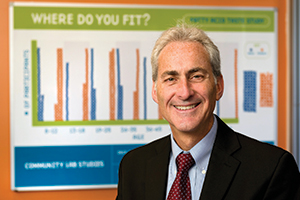
Rick Mattes visited the Genetics of Taste Lab at the Denver Museum of Nature & Science in July. Mattes is collaborating with the museum on research related to whether humans can taste fatty acids. (Photos by Rick Wicker, Denver Museum of Nature & Science)
Cross-country collaboration
The laboratory contributing to this research is unlike most others — it's a public exhibit on the second floor of the Denver Museum of Nature & Science. The Genetics of Taste Lab is a community-based program in the museum's interactive exhibit of human biology, and Mattes is collaborating with Nicole Garneau, the museum's curator and department chair of health sciences. The work may be a groundbreaking population study because of the breadth and depth of data that will be collected from visitors interested in participating as they engage in the museum's interactive research study within the exhibition.
"In addition to the research, it's a vehicle for educating the population about this sensory system," says Mattes, who directs Purdue's Ingestive Behavior Research Center. He studies the controls of human feeding and the mechanisms and functions of taste, and is known for his related work specific to nuts and beverages.
The unique venue will allow the researchers to attract up to 3,000 participants ages 8 and older. During a 45-minute study session, the participants taste and rate a series of dissolvable taste strips, similar to breath mint strips, but containing different taste compounds including fatty acids, and answer questions related to taste such as intensity and quality. They also provide a swab taken from the inner cheek for DNA analysis. By early August, nearly 600 people had participated in the study.
"The response has been really rewarding for us not only as scientists who need data, but as educators interested in using taste as a vessel to teach people about their genetics in a way that is accessible and personally relevant to their everyday lives," Garneau says. "For me, the best stories are about young participants, under the age of 10, who just wow their parents with their curiosity and their ability to take in, process and then ask incredible questions — really nuanced questions, about genetics, taste and health."
Another advantage to this study design is that many people who visit museums do so in family groups, so the information collected, which remains anonymous, will provide a pool of information amenable to the study of genetic and environmental influences on perception. The researchers are especially interested in twins. Understanding the genetics could help the researchers determine whether the taste of fat is inherent or acquired and may explain the wide individual variability in responses to oral fat exposure.
"This may help to explain fat preferences and food choice," Mattes says. "Taste influences what and how much people eat as well as food digestion and use of the nutrients they contain."
The information collected in this study will provide a large data resource that can be used for dozens of analyses. The research will be analyzed and then manuscripts of the findings will be submitted for publication in peer-reviewed professional journals. The evidence obtained will help to validate or refute the hypothesis that fat is a new taste quality.











